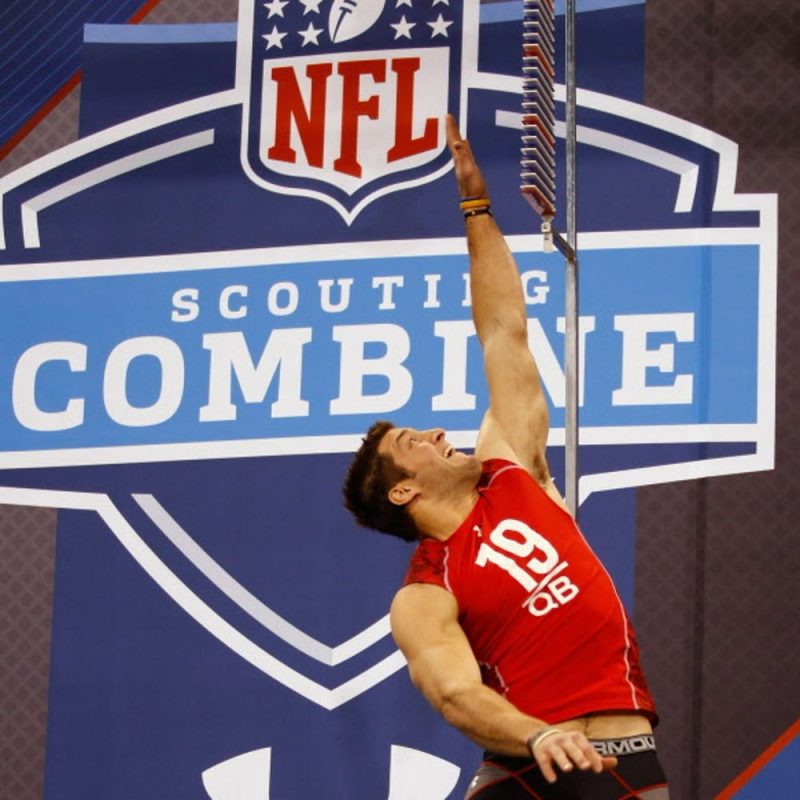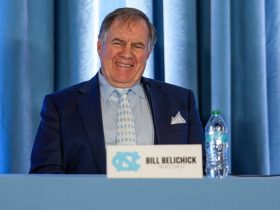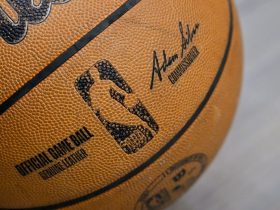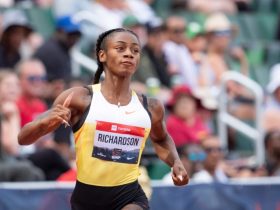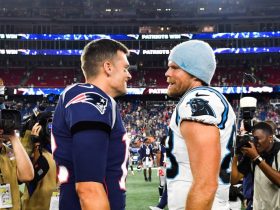Each year, hundreds of NFL draft hopefuls attempt to impress future employers with a dazzling display of skill and athleticism at the NFL scouting combine.
Part track meet, part grammar school fitness test, the combine is a cog in the NFL draft’s evaluation machine. This is also often the first time key decision makers in the league get a first-hand look at the fresh talent. And, as the saying goes, first impressions matter.
Sometimes way too much.
What happens in said workouts on Lucas Oil Stadium’s artificial turf by athletes clad in shorts and T-shirts can seemingly overshadow what transpired on the field in actual pads and cleats the previous autumn.
This is a look at those prospects whose work in Indy might have factored a bit too much into their overall draft evaluation. What followed? Well, mistakes were made.
(Important note: Tony Mandarich only participated in the physical exam and drug test at the 1989 combine. At his workout at Michigan State, he reportedly ran the 40-yard dash in 4.65 seconds and bench pressed 225 pounds an astonishing 39 times. He famously parlayed that workout into becoming the No. 2 pick in the 1989 draft by the Green Bay Packers, but would go on to an undistinguished NFL career.)
10. Tim Tebow
Position: Quarterback Draft: 2010, Round 1, No. 25 overallSelected by: Denver Broncos
The lowdown: Tebow — one of the most decorated and famous college football players of all time — entered the NFL with one glaring question to answer: Could he throw a football? As in, throw it with speed and accuracy in the confines of a complex offensive system. Tebow didn’t go through quarterback position drills at the combine since he was working on a revamped throwing motion that he would unveil to great fanfare at Florida’s pro day later that spring. Instead, he put on a display of his athleticism and seemed to impress teams with his football acumen in private meetings. The Broncos were enamored enough to trade back into the first round of the 2010 draft to get him. He had a memorable season in 2011, during which he led Denver on a series of come-from-behind wins and engineered an overtime triumph over the Pittsburgh Steelers in an AFC wild-card game. However, in 2012 the Broncos traded Tebow to the New York Jets after signing Peyton Manning. He attempted just eight passes while with the Jets, and after failed preseason stints with the New England Patriots and Philadelphia Eagles, Tebow turned his attention to television and becoming a pro baseball player — though he would make one more go of it in the NFL before being released by his hometown Jacksonville Jaguars during the 2021 preseason.
9. Tavon Austin
Position: Wide receiverDraft: 2013, Round 1, No. 8 overallSelected by: St. Louis Rams
The lowdown: At the 2013 combine, Austin ran a 4.34-second 40-yard dash, second only to Marquise Goodwin, who was a two-time NCAA long jump champion and competed at the 2012 Summer Olympics. With the days of Isaac Bruce and Torry Holt in the rearview in St. Louis, the Rams were desperate to replenish their once-proud receiving corps. They traded up in the draft to pick Austin (and also selected Austin’s West Virginia teammate, receiver Stedman Bailey, in the third round). Austin played nine seasons in the NFL with four different teams. Only once in his career did he have more than 500 receiving yards.
8. Stephen Hill
Position: Wide receiverDraft: 2012, Round 2, No. 43 overallSelected by: New York Jets
The lowdown: Hill played in an option offense while at Georgia Tech, so he jumped into the draft — doing so as an early entrant, as well — raw and inexperienced as a passing game component. What Hill did possess was speed. He had 4.36-second speed in the 40, and the Jets hoped that would open up their aerial attack. In his two seasons in New York, the team’s offense ranked 30th and 25th in total yards. Hill combined for 594 yards and four touchdowns in those two seasons, and his career was over in 2016.
7. Chris Henry
Position: Running backDraft: 2007, Round 2, No. 50 overallSelected by: Tennessee Titans
The lowdown: He posted less-than-impressive numbers during his four seasons at Arizona, never rushing for more than 600 yards in a year and only scoring nine touchdowns with a 3.3 yards-per-carry average. Still, a stellar combine workout — highlighted by a 4.4-second 40 time — can change minds quickly. Henry played in just 11 games — with no starts — in a four-year NFL career, rushing for 122 yards and scoring two touchdowns.
6. Aaron Curry
Position: LinebackerDraft: 2009, Round 1, No. 4 overallSelected by: Seattle Seahawks
The lowdown: He was considered an elite prospect heading into the combine. Curry solidified that lofty perch by running a 4.56-second 40 and posting a 37-inch vertical. The Wake Forest standout became the highest-selected linebacker since LaVar Arrington went No. 2 overall in the 2000 draft. Curry played in 30 games in his first two seasons but rarely made an impact. By 2011, his draft-bust status was nearly complete after he lost his starting job to K.J. Wright and was shipped to the Raiders in exchange for a seventh-round pick. Now, he’s molding the Steelers’ inside linebackers in his first role as an NFL position coach.
5. Darrius Heyward-Bey
Position: Wide receiverDraft: 2009, Round 1, No. 7 overallSelected by: Oakland Raiders
The lowdown: No team has been more romanced by prospects with blazing speed than the Raiders. Of the 14 players with the fastest 40 times at the combine since 2006, four were drafted by the Silver and Black (Heyward-Bey, Jacoby Ford, DeMarcus Van Dyke, Tyvon Branch). Heyward-Bey was a relatively unspectacular prospect coming out of Maryland, where he decided to forgo his senior season. That move paid off handsomely. Heyward-Bey’s 4.3-second 40 time boosted his draft stock, and the Raiders picked him over more heralded receivers in Michael Crabtree and Jeremy Maclin. Heyward-Bey lasted four seasons with the Raiders, collecting 11 touchdown passes and 2,071 yards receiving.
4. Mike Mamula
Position: Defensive end/LinebackerDraft: 1995, Round 1, No. 7 overallSelected by: Philadelphia Eagles
The lowdown: Mamula is the cautionary tale for putting too much stock in a combine performance. Turn back the clock to 1995, and it was rare that a draft prospect trained specifically for the combine’s drills. But such preparation paid off tremendously for Mamula, who had a 38½-inch vertical, ran a 40 that was extremely fast for his position (a reported 4.58 seconds) and had more bench press reps than the top offensive tackle in the draft (Tony Boselli). These numbers helped convince the Eagles to make an aggressive move to get Mamula, trading up five spots from No. 12 to No. 7 overall with the Tampa Bay Buccaneers. Five picks after the Eagles selected him, the Bucs took future Hall of Famer Warren Sapp.
3. Matt Jones
Position: Wide receiverDraft: 2005, Round 1, No. 21 overallSelected by: Jacksonville Jaguars
The lowdown: He played quarterback at Arkansas and even once held the Southeastern Conference’s record for rushing yards by a quarterback (later surpassed by Tebow). Jones’ athleticism prompted a position switch to help his draft status. At 6-6, he ran a sub-4.4 40. Mesmerized by a target with that enticing stature-and-speed combination, the Jags picked Jones, who was off the board six spots before the Atlanta Falcons took Roddy White and three selections before Aaron Rodgers fell to the Green Bay Packers. Jones lasted four seasons in Jacksonville, starting 15 games and catching 166 passes for 2,153 yards and 15 touchdowns. In 2009, Jacksonville had had enough of Jones’ off-field troubles and released him.
2. Troy Williamson
Position: Wide receiverDraft: 2005, Round 1, No. 7 overallSelected by: Minnesota Vikings
The lowdown: After trading Randy Moss to the Raiders, the Vikings were desperate to replicate that vertical threat in their offense. Williamson was fast (4.32-second 40), but he caught a bad case of the dropsies. He failed to hang on in Minnesota, lasting just three seasons and catching 79 passes (on 167 targets) for three touchdowns. He was unceremoniously shipped to the Jaguars in 2008 in exchange for a sixth-round pick.
1. Vernon Gholston
Position: Defensive endDraft: 2008, Round 1, No. 6 overallSelected by: New York Jets
The lowdown: He came out of Ohio State with all of the measurables that teams seek: size, speed, length, strength. But Gholston was raw and inexperienced. The 6-4, 258-pound physical specimen was impressive at the combine (4.67-second 40, 35½-inch vertical, 37 reps of 225 pounds on the bench), and New York was smitten, burning a top-10 selection on a player who would start just five games and record no sacks over three seasons with the team.
Follow USA TODAY Sports’ Jim Reineking on Twitter @jimreineking.

